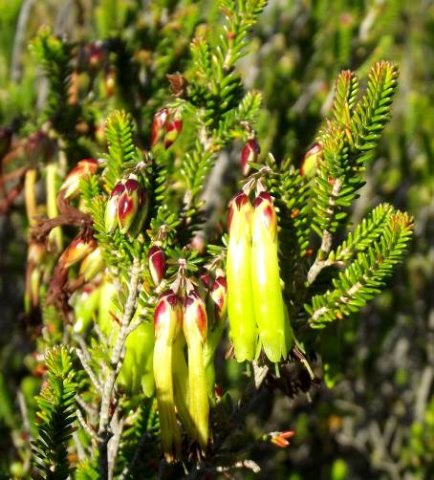Erica viridiflora subsp. viridiflora

Author: Ivan Lätti
Photographer: Louis Jordaan
Erica viridiflora subsp. viridiflora, commonly called green-flowered heath as the specific and subspecific names indicate and sometimes also coastal limegreen heath, is an erect, single-stemmed and much-branched shrub reaching heights around 90 cm. The branches are hairy, sometimes ageing into woody hairlessness.
The spreading leaves grow in whorls of three, sometimes hairy while the young leaves may have hairy margins. The needle-like to ovate leaves with bluntly pointed tips are from 3 mm to 8 mm long.
The flowers grow in stem-tip clusters of three. The nodding or drooping flowers have hairy pedicels of 3 mm to 5 mm long. Keel-tipped, lance-shaped bracteoles of 4 mm long are positioned close behind the calyces. The also keel-tipped sepals are ovate, up to 10 mm long and clasping the base of the corolla, resembling the bracts and in picture brown.
The cylindrical corollas are hairless, slightly sticky and slightly curved, about four times as long as the calyces. They are lime green or creamy yellow, up to 26 mm long. The stamens are included in the tube, but the style ending in pinhead stigma is sometimes exserted. The eight anthers are tailed. Flowering happens in spring.
The subspecies distribution is in the Western Cape in the coastal mountain ranges from George to the Eastern Cape as far as Humansdorp.
The habitat is rocky outcrops on moist fynbos mountain slopes. The habitat population of the subspecies is deemed of least concern early in the twenty first century (Manning and Helme, 2024; Vlok and Schutte-Vlok, 2015; Baker and Oliver, 1967; iNaturalist; http://redlist.sanbi.org).

